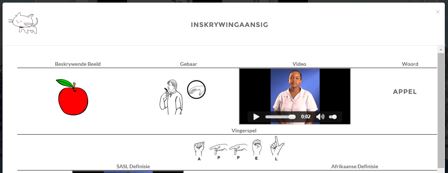A lexicographer and a computer science student from Stellenbosch University (SU) combined forces to develop the first prototype of a multimedia electronic dictionary for South African Sign Language.
Dr Hanelle Fourie Blair, assistant-editor of the Dictionary of the Afrikaans Language (WAT), developed a theoretical model of an electronic sign language dictionary for foundation phase learners for her doctoral thesis in lexicography in 2013.
Two years later, Hanno Schreiber developed the software for a multimedia electronic dictionary, based on her theoretical model, for his final year honours project in Computer Science at SU.
Why do we need a multimedia sign language dictionary?
Dr Fourie Blair says few people realise that sign language, just like any other spoken language, has its own distinctive linguistics (science of language) and grammar.
"I want to establish a culture where Deaf people and especially children have ease of access to user-friendly dictionaries, thereby developing a deeper reading culture. It is truly disheartening that most Deaf people do not read and therefore remain mostly illiterate. It does not have to be that way."
Up to now most text books for sign language in South Africa were written in such a way to assist hearing people to communicate with the Deaf, and not the other way round. There is also a glaring lack of language text books and dictionaries for Deaf children, compared to what are available for hearing children.
Dr Fourie Blair says Deaf children should also spend more time acquiring language skills than on speech therapy: "Why spend hours teaching a Deaf child to form and speak certain sounds, while they could have used that time to acquire the necessary language skills to discover the world of science and literature?
"The most natural and accessible language for a Deaf child is sign language. First establish their language skills. Then you can teach them all the other things," she says.
How does a multimedia sign language dictionary works?
The multimedia electronic dictionary functions without the principle of a specific source language or target language. In other words, users can search the dictionary by means of a picture, a sign or a word – each search method will lead to exactly the same result. The picture search method also implies that the user does not have to be literate in sign or written language to be able to use the dictionary.
Hanno says he was surprised at how well two completely different disciplines could work together: "Hanelle was the ideal study leader for such a software project. She explained concepts in her thesis that were unclear to me. We sat down and drew pictures until we were both on the same page. I kept her informed of my progress, and she gave feedback about what she liked and what she wanted to change. Her insight, patience and passion with this project made it a pleasure to work with her."
Dr Fourie Blair says it was wonderful to work with someone who could give life to her ideas: "Thanks to Hanno's project I can now demonstrate my idea to people. But there is still a lot of work ahead."
Institutions such as the Deaf Federation of South Africa has already expressed their interest in the project: "They are actually disappointed that the dictionary is not yet complete!" she laughs.
The next step is to gather the necessary content to transform the prototype into a usable multimedia dictionary. This includes decisions regarding content and material, followed by the writing of definitions and sample sentences, with accompanying pictures and videos of the signs, as well as videos of definitions and sample sentences in sign language.
Hanno will receive his Honours degree in Computer Science at SU's March 2016 graduation ceremony. He is currently working at the CSIR in Pretoria and plans to continue with an MSc in 2017.
"To me, the project was an opportunity to develop a system that will fill a gap and help the Deaf community. At the same time it was wonderful to be able to develop a comprehensive prototype of Hanelle's wonderful theoretical model," he adds.
For editors
Deaf versus deaf: In the literature a distinction is made between Deaf and deaf. People who are deaf have an audiological hearing problem but they do not use sign language (this is often people who became deaf later in life). People who are Deaf belong to a cultural and linguistic minority that uses sign language as their first language.

Above: After a search for the concept, word or sign "apple", the user will see a picture of an apple, the written word "apple" and a video of APPLE in sign language on the results page. A finger spelling of the word connects the written form and the visual form with the concept in sign language. Then follows a parallel structure where a definition and a sample sentence is given in written as well as sign language. This means that the dictionary is fully bilingual and bidirectional.
Contact details
Dr Hanelle Fourie Blair
E: hfourie@sun.ac.za
S: 082 725 3631
Hanno Schreiber
E: hanno.schreiber@gmail.com
Media release issued by Wiida Fourie-Basson, Media: Faculty of Science, science@sun.ac.za, 021 808 2684

